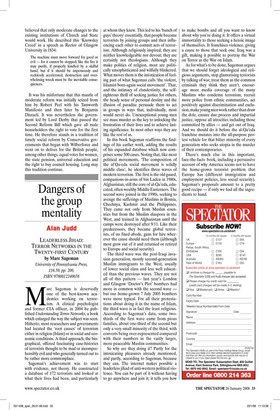Dangers of the group mentality
Alan Judd
LEADERLESS JIHAD: TERROR NETWORKS IN THE TWENTY-FIRST CENTURY by Marc Sageman University of Pennsylvania Press, £16.50, pp. 200, ISBN 9780812240658 Marc Sageman is deservedly one of the best-known academics working on terrorism. A clinical psychologist and former CIA officer, in 2004 he published Understanding Terror Networks, a book which enlarged the way the subject was seen. Hitherto, most researchers and governments had located the ‘root causes’ of terrorism either in religion (Islam) or in social and economic conditions. A third approach, the biographical, offered fascinating case-histories of terrorists thought to be mad or incomprehensibly evil and who generally turned out to be rather more commonplace.
Sageman’s achievement was to start with evidence, not theory. He constructed a database of 172 terrorists and looked at what their lives had been, and particularly at whom they knew. This led to his ‘bunch of guys’ theory: essentially, that people become terrorists by joining groups and then influencing each other to commit acts of terrorism. Although religiously inspired, they are neither knowledgeable nor devout; they are certainly not theologians. Although they make politics of religion, most are politically unsophisticated and wilfully blinkered. What moves them is the intoxication of feeling part of what Sageman calls ‘the violent, Islamist born-again social movement’. That, and the intimacy of clandestinity, the selfrighteous thrill of seeking justice for others, the heady sense of personal destiny and the illusion of paradise persuade them to act in groups in ways that, individually, most would never do. Unexceptional young men see mass murder as the key to unlocking the frustration of their lives and to achieve lasting significance. In most other ways they are like the rest of us.
In this book Sageman reaffirms the findings of his earlier work, adding the results of his expanded database which now comprises some 500 cases. Noting that, like most political movements, ‘The composition of the al’Qa-eda social movement is solidly middle class’, he identifies three waves of modern terrorism. The first is the old guard, companions-in-arms of bin Laden in 1980s, Afghanistan, still the core of al-Qa’eda, educated, often wealthy Middle Easterners. The second wave joined in the 1990s, seeking to avenge the sufferings of Muslims in Bosnia, Chechnya, Kashmir and the Philippines. They came not only from Muslim countries but from the Muslim diaspora in the West, and trained in Afghanistan until the camps were destroyed after 9/11. Like their predecessors, they became global terrorists, of no fixed abode, guns for hire wherever the cause should need them (although most grew out of it and returned or retired to Europe and social security).
The third wave was the post-Iraqi invasion generation, mostly second-generation Muslim immigrants to the West, usually of lower social class and less well educated than the previous waves. They are not all of this pattern — last year’s London and Glasgow ‘Doctor’s Plot’ bombers had more in common with the second wave — but our home-grown 7 July 2005 bombers were more typical. For all their protestations about doing it in the name of Islam, the third wave is in fact the least religious. According to Sageman’s data, some twothirds of the first wave came from pious families, about one-third of the second but only a very small minority of the third, with converts being over-represented compared with their numbers in the vastly larger, more peaceable Muslim communities.
So why are they doing it? Partly for the intoxicating pleasures already mentioned, and partly, according to Sageman, because they can. The internet makes possible a leaderless jihad of anti-western political violence. You can be part of it without having to go anywhere and join it; it tells you how to make bombs and all you want to know about why you’re doing it. It offers a virtual immortality to those seeking a heroic image of themselves. It franchises violence, giving a cause to those that seek one. Iraq was a gift, making it possible to portray the War on Terror as the War on Islam.
As for what’s to be done, Sageman argues that we should forget ideological and religious arguments, stop glamorising terrorists by talking of war, treat them as the common criminals they think they aren’t, encourage more media coverage of the many Muslims who condemn terrorism, recruit more police from ethnic communities, act positively against discrimination and exclusion, make young men work rather than draw the dole, ensure due process and impartial justice, oppose all atrocities including those committed by allies — and get out of Iraq. And we should do it before the al-Qa’eda franchise mutates into the all-purpose protest vehicle for that bitter minority of every generation who seeks utopia in the murder of their contemporaries.
There’s much else in this important, face-the-facts book, including a persuasive account of why America seems not to have the home-grown terrorist problem that Europe has (different immigration and employment policies, less social security). Sageman’s proposals amount to a pretty good recipe — if only we had all the ingredients to hand.










































































 Previous page
Previous page